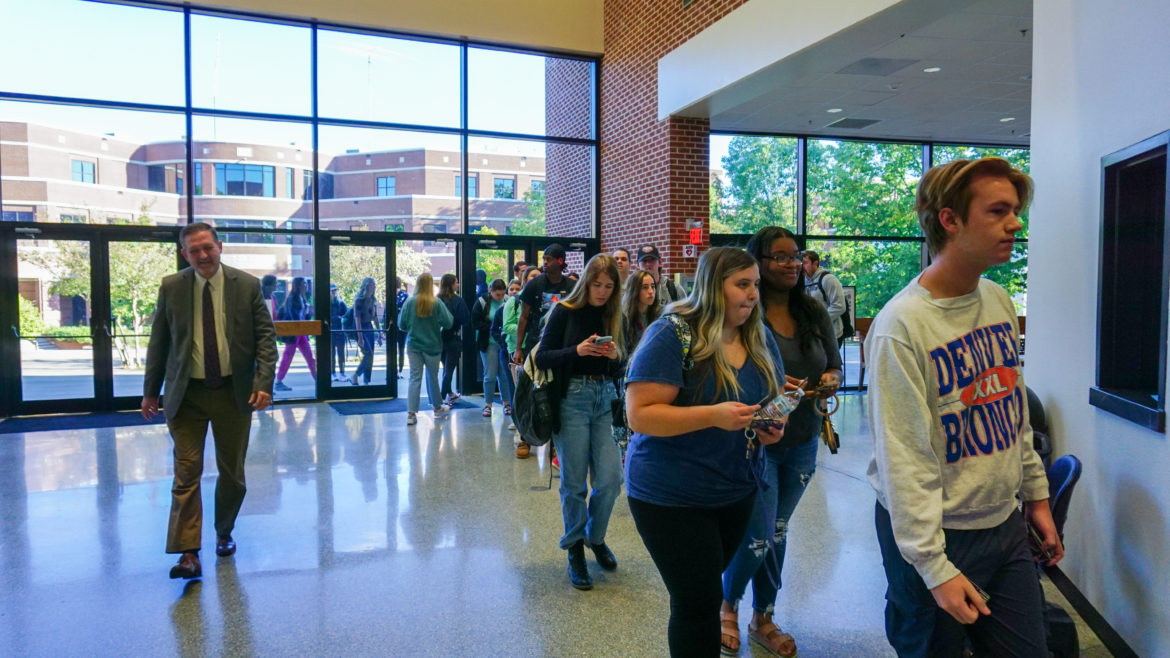Logan Light, assistant dean for Campus Life and Chapel Programs, announced the implementation of a new swipe-in system for students on Monday, Oct. 3, during chapel service in Benson Auditorium, indicating that the system would serve as the new way for students to check into chapel. The changes were applied immediately the next day.
Associate Dean of Students Kara Abston explained that card readers are now stationed at each entrance to the auditorium along with a chapel checker to operate each one with a tablet. Students are required to use their student IDs to swipe in and then walk to their assigned seat.
Abston said those whose seats are situated on the Benson floor are free to swipe through any entrance, though they are encouraged to use the entrances that correspond to their section to prevent an overflow of students at one entryway and allow them to become familiar with a chapel checker. Those who sit in the balcony are supposed to use the lobby stairway entrances.
The system offers the University the opportunity to conduct chapel in a new way, which includes holding breakout chapels — an alternative chapel that will give students the option to choose between smaller chapel programs.
“It is really going to be wonderful when we do breakout chapels,” Abston said. “And we have that opportunity to use those tablets elsewhere on campus. So it’s just gonna open up a lot of possibilities.”
Abston said the process of looking for a new check-in procedure began when University President Mike Williams and Executive Vice President Jean-Noel Thompson asked the Office of Student Life to create a new way of monitoring chapel attendance. One reason why the subject emerged was because Student Life was using an old camera system, and the dimmer lighting being used this semester made checking attendance difficult for staff. According to Public Safety director Craig Russell, the Benson cameras were first installed to check chapel attendance in 2007.
Student Life initially contemplated utilizing a system that would allow students to tap their cards on a card reader, but such a system would have required hardwiring and additional construction to the Benson walls, Abston said.
So they searched for other avenues and visited other private schools to observe how they recorded chapel attendance, including Faulkner University in Montgomery, Alabama, where Williams served as president before coming to Harding. Student Life soon opted to employ the swiping system, a program that Harding’s information technology staff developed, Abston said.
The new system is uploading attendance records to Pipeline in a shorter amount of time.
“So students can see their absence within two hours, where they used to not see it all day,” Abston said.
With the new change came new job opportunities as Student Life needed students to help man the card readers. Abston said there are currently about 15 student workers.
“Matter of fact, we have a lot that have reached out asking for that position,” Abston said. “So I think it will be in demand.”
Senior Karrisa Neal said she has enjoyed her new job thus far.
“I may be the black sheep of the bunch, but I love it because I get to be one of the first people that everyone sees — if they’re coming through my door — on the way to chapel,” Neal said. “I think my spiritual gift is encouragement, so I really love getting to greet everyone in the morning.”
Students with scratched IDs may need to replace their cards at the Public Safety office, but Abston said those charges are covered by the University if the cards work properly everywhere else outside of chapel.
After attending chapel the Wednesday following the announcement, junior Zane Edwards said he feels it should not be his responsibility to swipe for attendance.
“I think if Harding wants to take attendance in chapel, they need to make a system where we just have to show up,” Edwards said. “And I think if the photo system was too time consuming, then they need to figure out a better way to do that. But I don’t like having to scan in, and I don’t want to tap in. I don’t want to do anything but sit in my seat at 9 a.m.”
On the same day, senior Ashley Rehmel said she had mixed feelings about the new system.
“When I first heard about it in chapel on Monday, I was a little apprehensive because it’s new and new things typically tend to not work for the first several weeks that they’re in use,” Rehmel said. “And it kind of seemed like it might have held up the lines, but it went OK today. … I’m tentatively optimistic, and it is nice that it will make it easier on the people who don’t have to go in and count heads now.”
On Oct. 3, Light also revealed that students will continue to have assigned seating. Weeks prior to this announcement, Student Life gave students the opportunity to electronically vote on whether to keep their assigned seats, eliminate assigned seating altogether or establish a combination of both. Out of 1,612 students who voted, 21.84% advocated for a combination, 29.53% endorsed eradicating assigned seating and 48.64% voted to retain the status quo.
Senior James Phillips said he did not mind the results nor the new card reader system.
“The scanning system is fine,” Phillips said. “I think it would make more sense in conjunction with unassigned seating, but I like my assigned seat, so I like that it’s kept that way.”
